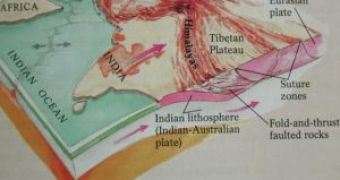About 55 million years ago, the Indian plate collided with Eurasia and the place of collision (the land) was forced to slowly rise.
This way appeared the Himalayan Mountains, the highest in the world, and the Tibetan Plateau, world's largest and highest, compassing an area as big as 10 % of the U.S., and averaging 5,000 m (16,000 feet) in elevation.
Geologists made many tectonic models of how Tibet appeared, from subduction of the Eurasian plate, subduction of the Indian plate, to thickening of the Eurasian lithosphere (the outermost layer of rocks).
According to the last model, the thickened lithosphere turned unstable, and a piece was torn and sank into the deep mantle.
Now geologists at the University of Illinois at Urbana-Champaign have spotted beneath Tibet a huge chunk of Earth's lithosphere that went missing 15 million years ago, a discovery that could explain at last how plates behave when they collide.
"While attached, this immense piece of mantle lithosphere under Tibet acted as an anchor, holding the land above in place," said Wang-Ping Chen, a professor of geophysics at the UI.
"Then, about 15 million years ago, the chain broke and the land rose, further raising the high plateau."
This theory got a proof when the missing anchor was discovered by doctoral student Tai-Lin (Ellen) Tseng and Chen.
"This remnant of detached lithosphere provides key evidence for a direct connection between continental collision near the surface and deep-seated dynamics in the mantle," Tseng said.
"Moreover, mantle dynamics ultimately drives tectonism, so the fate of mantle lithosphere under Tibet is fundamental to understanding the full dynamics of collision."
The team analyzed the seismic signals picked up by permanent and temporary stations placed from the Indian plains, through Nepal, over Himalaya into the central Tibet in a project named Hi-CLIMB.
"With more than 200 station deployments, Hi-CLIMB is the largest broadband (high-resolution) seismic experiment conducted to date," said Chen.
Seismic waves reaching depths of 300 to 700 km provided a detailed seismic profile.
These waves cross faster through colder rock, unveiling their position.
"We not only found the missing piece of cold lithosphere, but also were able to reconstruct the positions of tectonic plates back to 15 million years ago," Tseng said.
"It therefore seems much more likely that instability in the thickening lithosphere was partially responsible for forming the Tibetan Plateau, rather than the wholesale subduction of one of the tectonic plates."
Other data, like the age and the location of volcanic rocks, also confirm that this chunk broke off about 15 million years ago.

 14 DAY TRIAL //
14 DAY TRIAL //